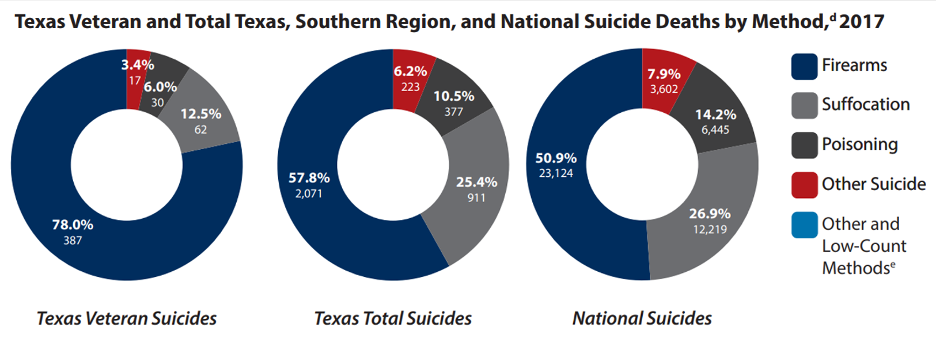Rising suicide rates in Texas represent a growing concern for everyone who cares about mental health and well-being. While the rate is highest in middle aged and elderly white males in rural communities, suicide impacts all demographics uniquely. People with physical and mental disabilities, LGBTQ+ youth, and racial minorities all face particular discrimination that discourages them from seeking mental health treatments. The COVID-19 pandemic is expected to amplify mental health concerns such as suicide.
Suicide Data
Since 2000, the Texas suicide rate has risen nearly 36 percent.[i] In 2017, suicide was the second leading cause of death in Texas for those aged 15-34.[ii] Males are over 3.5 times more likely than females to die by suicide, and white Texans are over two times as likely to die by suicide as Asian, black, and Hispanic Texans.[iii] These statistics have deep ramifications for individuals’ mental well-being. Centers for Disease Control and Prevention data indicated that 46 percent of suicide victims also have diagnosed mental health conditions.[iv] Individuals are particularly at risk after experiencing reductions in their health care. Mental health parity laws, which facilitate access to mental health services, can reduce suicide rates.[v]
While all suicide attempts have an 8.5 percent death rate, those involving firearms are the number one cause of suicide death and have an 89.6 percent mortality rate.[vi] As the figure below indicates, populations with higher rates of gun ownership tend to have higher suicide rates.[vii] This is most prevalent with the Texas veteran population, who have higher rates of trauma, and among rural residents who are nearly two times more likely to die by firearm suicides than urban residents. The difficulty in providing timely medical care to isolated residences also contributes to this higher mortality rate[viii] Limiting access to lethal means is therefore pivotal to preventing suicide.

Impacts of COVID-19
Due to COVID-19, researchers predict we’ll see an increase in suicides. This is primarily due to physical and social distancing, financial hardships, and the trauma faced by loved ones of individuals who have died or become critically ill from the virus. During the 2007 Great Recession, there was a 1.6 percent increase in the suicide rate for every percentage point increase in the unemployment rate. Based off this trend, a 20 percent increase in unemployment resulting from COVID- 19 could result in an estimated 18,000 more Americans dying by suicide.[ix] Black Texans could be at even higher risk of suicide given their disproportionately higher death rates from COVID- 19.[x] The expansion of telemedicine and telehealth is vital to continuing to serve the mental health needs of Texans.[xi] The permanent use of these services could help Texans experiencing mental health conditions from this pandemic, which could lead to less suicides than otherwise anticipated.
Accessing Care in Communities of Color
Even though adult black Americans are more likely than adult white Americans to report “feelings of sadness, hopelessness, worthlessness, or that everything is an effort”,[xii] black Americans are less likely to seek out treatment and more likely to end treatment prematurely.[xiii] This is due to financial and healthcare restraints caused by systemic racial oppression, long-held stigmas against seeking help within the community, and the inability of some healthcare providers to establish themselves as credible and reliable sources of support. The history of discrimination in healthcare, especially against black women, has led many people of color to hold a fundamental mistrust of some healthcare services.[xiv] To address suicide within communities of color, it is vital that policies increase mental health care access and incentivize these services to be utilized.
Texas Legislature
The 86th Texas Legislature passed several bills in 2019 to address suicide. HB 3980 directed the Texas Health and Human Services Commission and Department of State Health Services to publish a report, based off the work of a stakeholder workgroup, on the prevalence of suicide in Texas and the state’s prevention efforts.[xv] HB 906 created the Collaborative Task Force on Public School Mental Health Services to study the suicide rate of school employees, students, and family/guardians receiving state-funded mental health services.[xvi] SB 11 added suicide prevention and mental health instruction to public school health curricula, and provided districts with annual funding allotments to support student mental health and suicide prevention strategies.[xvii] These strategies were guided by HB 18, which established strategies to help school districts support the mental health needs and development of their students, including comprehensive suicide prevention. [xviii]
The effects of this legislation remain to be seen, especially given the COVID-19 pandemic. But we have it in our power to make change. By increasing access to care, reducing access to lethal means, dismantling stigmas against seeking mental health treatment, and reducing discriminatory disparities, we can meet the challenge of reversing the suicide trend in Texas.
If You Need Support
Texans experiencing thoughts of self-harm can call the National Suicide Prevention Lifeline at 1-800-273-8255, or visit suicidepreventionlifeline.org for more information.
Related links
- For World Mental Health Day, take 40 seconds
- What Happens When You Call a Suicide Hotline?
- Community Approaches to Suicide Prevention
References
- [i] https://hhs.texas.gov/sites/default/files/documents/laws-regulations/reports-presentations/2020/suicide-prevention-texas-may-2020.pdf
- [ii] https://chapterland.org/wp-content/uploads/sites/13/2019/05/Texas-State-Facts-2019.pdf
- [iii] https://www.americashealthrankings.org/explore/annual/measure/Suicide/state/TX
- [iv] https://www.cdc.gov/vitalsigns/pdf/vs-0618-suicide-H.pdf
- [v] https://www.rand.org/research/gun-policy/analysis/essays/mental-health-access-and-suicide.html
- [vi] https://www.acpjournals.org/doi/10.7326/M19-1324
- [vii] https://www.mentalhealth.va.gov/docs/data-sheets/2017/Texas_Veteran_Suicide_Data_Sheet_2017.pdf
- [viii] https://www.cdc.gov/ruralhealth/suicide/policybrief.html
- [ix] https://www.texasstateofmind.org/uploads/whitepapers/COVID-MHSUDImpacts.pdf
- [x] https://www.apmresearchlab.org/covid/deaths-by-race
- [xi] https://www.policymed.com/2020/04/covid-19-hhs-and-fcc-telehealth-changes.html
- [xii] https://minorityhealth.hhs.gov/omh/browse.aspx?lvl=4&lvlid=24
- [xiii] https://www.thenationalcouncil.org/BH365/2019/07/08/stigma-regarding-mental-illness-among-people-of-color/
- [xiv] https://www.hsph.harvard.edu/news/hsph-in-the-news/discrimination-black-womens-health/
- [xv] https://legiscan.com/TX/text/HB3980/id/2021748
- [xvi] https://legiscan.com/TX/text/HB906/id/2027496
- [xvii] https://legiscan.com/TX/text/SB11/id/2027985
- [xviii] https://legiscan.com/TX/bill/HB18/2019
